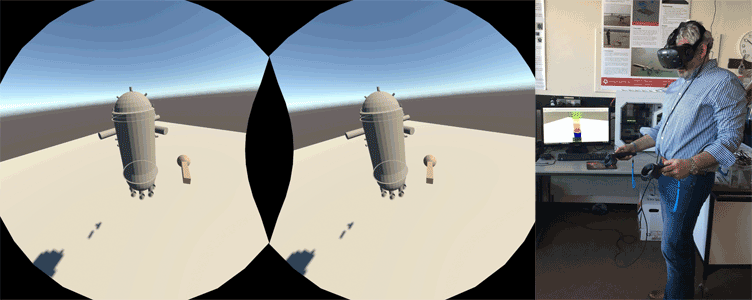Virtual Reality Advanced Boiling Water Reactor Simulator - (08/2017 - 12/2017, AWBR/BU)

There is a huge opportunity to use Virtual Reality (VR) to help people understand the Boiling Water Reactor. Through using VR, users would be able to walk around, see how the BWR works, interact with it, and become excited about its function and technology, through the excitement of the VR experience itself.
This feasibility study aims to develop a prototype HMD-based VR demonstration of an ABWR facility. It aims to present to the user 3D simulations of how an Advanced Boiling Water Reactor works. By providing this immersive demonstration, users can learn about this technology, its significance, explore the facility virtually and learn about the potential of nuclear power in an immersive, interactive and highly engaging manner. The prototype will be designed from the outset to be extensible and adaptable to include additional information in the future, such as data-driven informational annotations and immersive visual analytics.
You can find more information in the BWR Research Hub and Network website.
We gratefully acknowledge the support of NVIDIA Corporation with the donation of a Titan Xp GPU used for this research.
Related Publications
P. D. Ritsos and J. C. Roberts, “Virtual Reality Demonstrator of an Advanced Boiling Reactor,” Bangor University, Technical Report, 2018.
This feasibility study presents an overview of the development of a prototype HMD-based VR demonstration of an ABWR facility. The demonstration aims to present to the user 3D simulations of how an Advanced Boiling Water Reactor looks like, and eventually how it works. By providing this immersive demonstration, users can learn about this technology, its significance, explore the facility virtually and learn about the potential of nuclear power in an immersive, interactive and highly engaging manner. The prototype was designed from the outset to be extensible and adaptable to include additional information in the future, such as data-driven informational annotations and immersive visual analytics. The feasibility study demonstrated the ease and flexibility of modern game engines and VR interfaces, in prototyping a VR simulator, intended as a for demonstration tool for an ABWR. However, it also highlighted the need for high-quality 3D models of the elements of the reactor that are to be depicted, in enhance immersion and realism of depiction. Moreover, if any informational overlays are to be used, in conjunction with the 3D information, these need to be sourced from informative and accurate datasets, that would accompany the aforementioned 3D models. Finally, as the set-up used in this effort is not mobile, and outreach activities would benefit from such mobility, we have started exploring the development of a Web-based, mobile solution that uses a simpler, highly-portable infrastructure.
[Abstract]
[Details]
[PDF]